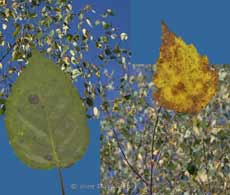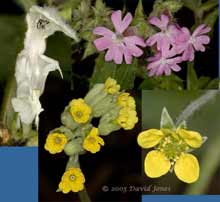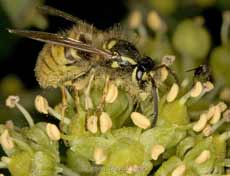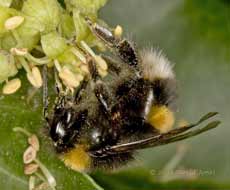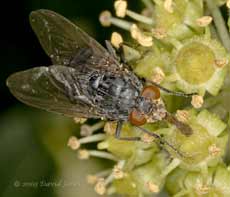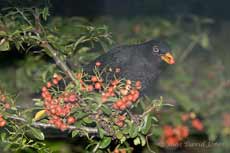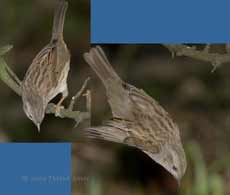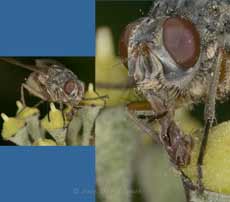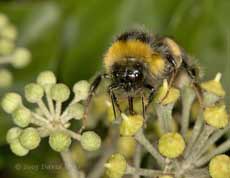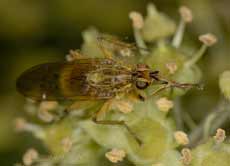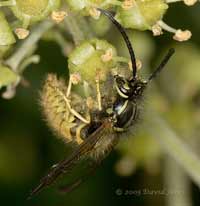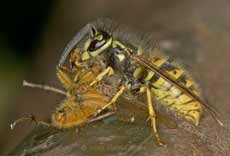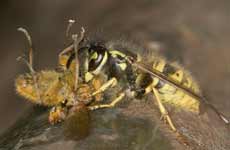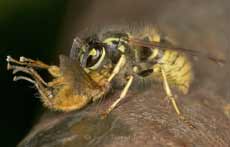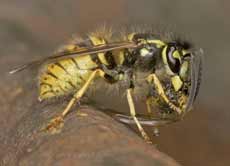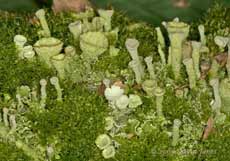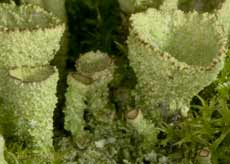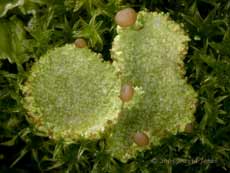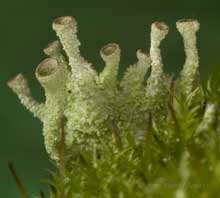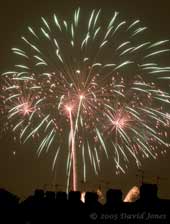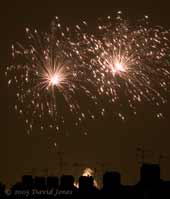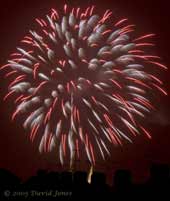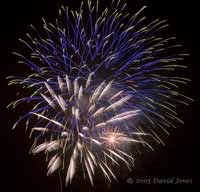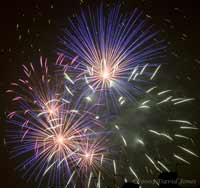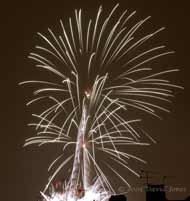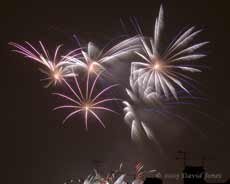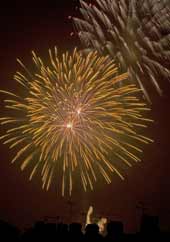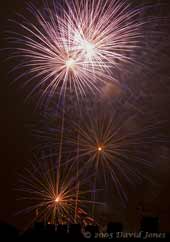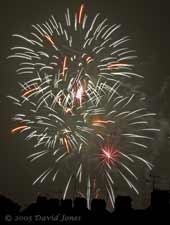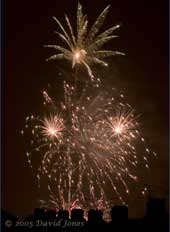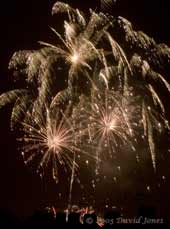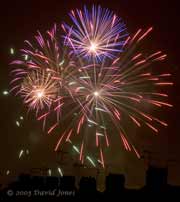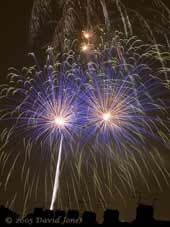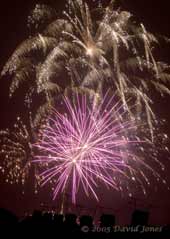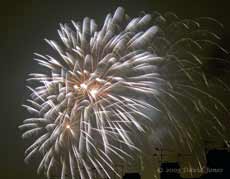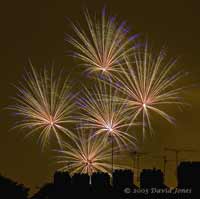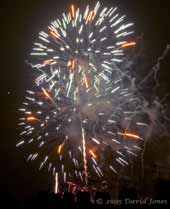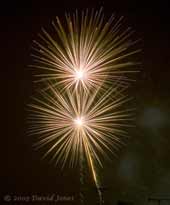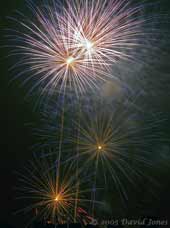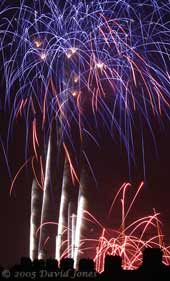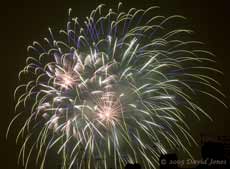Go to the last entry on this page .....Go to previous entry1 November - I'm still struggling with the time change as we move into November, but it did mean that I was up early to see the start of a bright, largely sunny, and very pleasant day. However, the maximum temperature was down a couple of degrees to under 13C, noticeable when I spent some time up on the scaffold tower in the early afternoon.
Even our Birch comes alive in the breeze as the lighter undersides of the leaves catch the sunlight (left). I've included an image of a fallen leaf from each tree for comparison.
Down at ground level there are only occasional flashes of colour amongst the green to start the month. There are numerous Red Campions in bloom and a few White Dead-nettles. In addition an Oxlip has sent up a flower head (lower-centre) and this morning I found a solitary Wood Avens (lower-right). There is also a single primrose flower, although this is badly moth (caterpillar) eaten!
The Ivy was much quieter today. There was still a Red Admiral about which didn't come close enough to photograph. There were very few hoverflies, being outnumbered by the small number of wasps that were feeding here.
I didn't see any social bees, but there were small numbers of Bumblebees about - as far as I can tell, they are all Buff-tailed Bumblebees.
Today it was the true flies that were clearly most numerous, lapping up the nectar with a pad-like proboscis.
Since we bought the new Goldfinch feeder we have noticed how the old feeder was emptying much more quickly despite having only two perches as opposed to the new feeders' six.
The difference in what the trays have collected is clear. The left one has piles of seeds and seed husks below three of the four circular holes that are in the (old) feeder. Each hole is about 5mm in diameter, about the same length as the seeds. This means that every time the feeder is disturbed, or a Goldfinch pecks at a hole several seeds fall out. The holes on the new feeder are narrow, no more that 2mm wide and just over 5mm in length, big enough for the birds to get seeds from inside by preventing more than a little spillage from taking place. The next time I go to the garden centre that sells the yellow feeder we will be buying a second one - the cost will probably be balanced by the saving in wasted seeds through the winter.
2 November - Yesterday's good start to the month hasn't been repeated today. There was rain in the night, and the grey clouds have stayed with us, bringing rain throughout the day. In the garden it has been a day of missed photo-opportunities. This morning we had the first Sparrowhawk attack for a long time. By the time I got upstairs to our bedroom the hawk had given up and all I saw was a rear view as it flew off, without any prey. At lunchtime I walked out of the back door and caught a momentary glimpse of a bird fly up from the far end of the garden. Its call was not one of our usuals - a pair of sharp sounds. It flew high up into the air, and its silhouette was that of a thrush. Consulting my bird books, the nearest match I have come up with is a Fieldfare, a bird I have seen here just once before, at the beginning of March last year. I heard it again later in the afternoon. The Fieldfare is a Winter visitor from Scandinavia. On its previous visit it ate apples, so I made a quick trip to get some.
3 November - We were looking forward to gales today, but they seemed to more or less miss us. It was wet first thing this morning and there was a strong breeze. It became drier as the morning progressed and there were only occasional stronger gusts of wind (35mph was the highest gust recorded at the local weather station). The trees were not impressed, and very few leaves were shed. I was doing various jobs today, so I didn't have much time to watch the birds today. I didn't hear or see any signs of yesterday's visitors. What I did notice soon after dusk was the sound of five or six frogs croaking in the vegetation around the ponds. A new bit of kit arrived today, an Apacer Disc Steno 200 that will allow me to transfer images directly from memory card to CDs when we are holiday. My laptop takes ages to do that job so the Steno will be very helpful. 4 November - A bright, largely sunny day with no more than a breeze before what is promised to be a wet weekend, if the forecast is correct.
Unfortunately, the branch was bouncing and took the Blackbird's head out of focus as I pressed the shutter. It could have been a decent candidate for the November picture for next year's calendar (which I haven't even started yet!!).
A Wren appeared briefly again today. I didn't get a chance to photograph it, but I did grab this pair of images of a Dunnock heading down to feed from the lower branches of the Hawthorn.
It was sunny at lunchtime so I spent about an hour up on the scaffold tower again. There are fewer flowers in bloom now, but there are also still buds, so I think flowering will continue for at least the next week. The temperature was about 13C, although it felt warmer in the sunshine, and insect activity was definitely less than on my last visit. There were many fewer hoverflies, and those that I saw were mainly drone-flies and a few Syrphus ribesii. I had wondered if I would see a Red Admiral, but there was no sign of any today.
At this stage the flowers secrete a liquid onto their conical tops, presumably to attract insects that may deposit pollen onto the stigma that protrudes from the middle of the cone.
Again, I saw no social bees but Bumblebees continue to visit, feeding on nectar, as well as collecting pollen.
There were also a few Yellow Dung flies about, both feeding and in ambush posture. This one was cleaning its front legs after its nectar meal was over.
There were wasps about. These seem to feed on both pollen and nectar - for most of the time.
I had just relaxed for a moment, when this
wasp suddenly grabbed a Dung Fly and brought it to the scaffold tower,
inches away from my hand. When I took this first image, the fly was still
alive.
A few seconds later the wasp had bitten off the fly's head -you can see it, discarded, just below the fly's body, just before the wind blew it away.
With the fly still kicking, the wasp then
turned its attention to the fly's abdomen, and then ....
the abdomen fell away, leaving the wasp
with its jaws holding onto the thorax, with wings and legs still attached.
It then spent time chewing on this last bit of the fly before flying off with it still held in its jaws. It has been suggested that the wasp was interested in the flight muscles, which are in the thorax.
It was fascinating to watch - the Dung Fly preys on small flies, the wasp on Dung Flies and small insects, and, as I saw a week ago, the wasp can itself fall prey to a Hornet! Just before I got down from the scaffold, I saw a wasp grab a Bluebottle. The pair disappeared into the foliage so there was no chance to get photographs this time.
5 November - Bonfire Night (a celebration(?) of the failed attempt by Guy Fawkes and his associates to blow up the Houses of Parliament 400 years ago). As I begin to write this at 4.30pm, today's promised rain has held off, bar a few spots during the afternoon. Some of the clouds have a threatening appearance - fingers crossed that it stays fine for tonight's firework display in our local park. In an optimistic move I've clamped a tripod head with a quick-release mount to the top of the scaffold tower, and all being well I should be able to get some photographs this evening. The wind is in my favour as it will tend to make the high rising fireworks drift into open space, away from trees that would otherwise block the view. This morning I took advantage of the sunshine to climb not the tower but a step-ladder by the side of our caravan shelter. The top of the shelter is covered with an industrial strength tarp which has been in place for some ten years (I think!). It has done well, surviving winter storms and the strong summer sunshine. However, when the wind blew it did tend to flap up and down noisily against the framework.
I first recorded these growths in December last year, and since then they have become far more dense, to the extent that much of the rope is now completely hidden from sight.
Lichens are a symbiotic organism made up of fungal filaments living in a strange alliance with an algal species (in this case a green alga). I believe that this one is Cladonia pyxidata, a common species also know, for obvious reasons, as the Pixy-cup Lichen. The nature of lichen means that they can dry completely when there is no water available, but will quickly become soft and fleshy again when water is again available - a handy property on the caravan shelter. C. pyxidata is a fruticose species, which means it produces stalks. These are usually cup-shaped at the top and are called podetia. Especially lower down, you can see that the stalks are covered with scales called squamules.
Around the rims of the cups, brown spore-bearing bodies are produced, sometimes growing relatively large.
In a couple of cases, instead of there being a rounded body there was a small stalk growing out of the rim (lower-right). That, in turn had its own brown rim.
In this extreme example, these stalks all appear to be growing out of the rim of an existing cup. I need to search more thoroughly for information about lichen. So far I have only been able to find bits and pieces about these odd organisms.
And now the firework display..... Having stayed dry all day, it started drizzling shortly before the 7.35pm start of the show. It wasn't too bad, and the cloud cover stayed high, so the camera was put in place (with a polythene rain cover) at the top of the tower. The tower wobbled with me on it, so after I used the first few fireworks to make final adjustments, I used a long cable release to open the shutter whenever it seemed a good idea. and finally ....
6 November - After yesterday's escape from the rain, today we have been wet, with a mixture of drizzle and heavy showers. It has been a miserably soggy day, although, as I write this at 5.15pm (with it dark and damp outside) it sounds as if someone is endeavouring to have a firework display. Not having picked up my camera today, I have instead found some fireworks left over from last night....... ... and that really is the end of the display - only some duds, and ones that went too high or too wide are left in the box, ready to be put in the recycle bin! Click on the images to see larger versions - |
|
